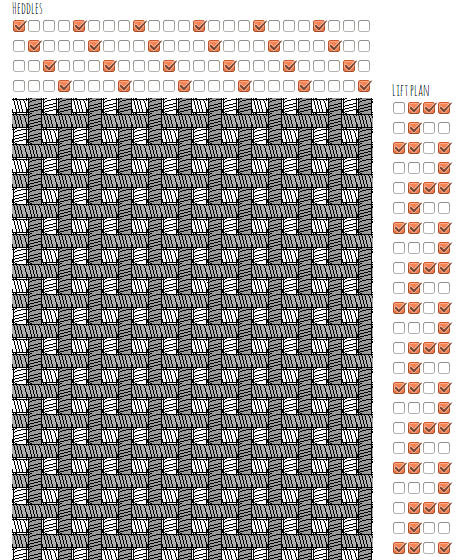Double weave has intrigued me since first figuring out how it works with tablets – it shows how weaving is a 3D process, and is an example of shape making from code. It’s the starting point for more advanced methods for creating strong woven composite materials and structures. I’ve been reading this document by Paul O’Connor to understand the process for a 4 shaft loom. He includes this critique on current methods for visualising weaving:
The traditional method for creating the drawdown shows all the warp and all the weft threads in one layer. What is needed is a way to make two drawdowns, one for the top cloth layer and the other for the bottom cloth layer. Most of the commercially available computer weave programs display the drawdown in this same fashion, as a single layer.
This is a draft plan (the traditional notation technique) for double weave which contains the drawdown he’s talking about:
Drawdowns are designed for thinking about weaving as 2D pattern, and like any notation system they abstract a situation so we can reason about it, with the trade-off that they make it impossible to understand different aspects. This is a big problem we have in programming too – and is the reason we need to have many levels and hundreds of different languages to describe problems. I’ve noticed that if people (or organisations) stick with one too long, the specialisation starts to hinder ability to even recognise certain issues. It’s interesting to see such a clear analogy here.
In order to see what’s really happening with double weave, we need to switch to a different notation and look at the structure more closely:
Hopefully you can see that all of the black threads are sitting on top of all the white threads, and forms it’s own plain or tabby weave fabric. The same is true for the white threads underneath. Below is the same structure rendered in the weavecoding dyadic device – this shows the heddles that need raising to create the sheds in the lift plan, and you can see a repeating zigzag pattern. As an aside, I’ve noticed that there seems to be some kind of underlying categorisation of lift plan patterns which I’ve not found mentioned anywhere yet – something else to look into at some point.


